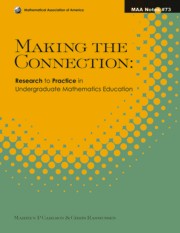Book contents
- Frontmatter
- Preface
- Contents
- Part 1 Student Thinking
- Part 2 Cross-Cutting Themes
- 2a Interacting with Students
- 13 Meeting New Teaching Challenges: Teaching Strategies that Mediate Between All Lecture and All Student Discovery
- 14 Examining Interaction Patterns in College-Level Mathematics Classes: A Case Study
- 15 Mathematics as a Constructive Activity: Exploiting Dimensions of Possible Variation
- 16 Supporting High Achievement in Introductory Mathematics Courses: What We Have Learned from 30 Years of the Emerging Scholars Program
- 2b Using Definitions, Examples and Technology
- 17 The Role of Mathematical Definitions in Mathematics and in Undergraduate Mathematics Courses
- 18 Computer-Based Technologies and Plausible Reasoning
- 19 Worked Examples and Concept Example Usage in Understanding Mathematical Concepts and Proofs
- 2c Knowledge, Assumptions, and Problem Solving Behaviors for Teaching
- 20 From Concept Images to Pedagogic Structure for a Mathematical Topic
- 21 Promoting Effective Mathematical Practices in Students: Insights from Problem Solving Research
- 22 When Students Don't Apply the Knowledge You Think They Have, Rethink Your Assumptions about Transfer
- 23 How Do Mathematicians Learn To Teach? Implications from Research on Teachers and Teaching for Graduate Student Professional Development
- About the Editors
21 - Promoting Effective Mathematical Practices in Students: Insights from Problem Solving Research
from Part 2 - Cross-Cutting Themes
- Frontmatter
- Preface
- Contents
- Part 1 Student Thinking
- Part 2 Cross-Cutting Themes
- 2a Interacting with Students
- 13 Meeting New Teaching Challenges: Teaching Strategies that Mediate Between All Lecture and All Student Discovery
- 14 Examining Interaction Patterns in College-Level Mathematics Classes: A Case Study
- 15 Mathematics as a Constructive Activity: Exploiting Dimensions of Possible Variation
- 16 Supporting High Achievement in Introductory Mathematics Courses: What We Have Learned from 30 Years of the Emerging Scholars Program
- 2b Using Definitions, Examples and Technology
- 17 The Role of Mathematical Definitions in Mathematics and in Undergraduate Mathematics Courses
- 18 Computer-Based Technologies and Plausible Reasoning
- 19 Worked Examples and Concept Example Usage in Understanding Mathematical Concepts and Proofs
- 2c Knowledge, Assumptions, and Problem Solving Behaviors for Teaching
- 20 From Concept Images to Pedagogic Structure for a Mathematical Topic
- 21 Promoting Effective Mathematical Practices in Students: Insights from Problem Solving Research
- 22 When Students Don't Apply the Knowledge You Think They Have, Rethink Your Assumptions about Transfer
- 23 How Do Mathematicians Learn To Teach? Implications from Research on Teachers and Teaching for Graduate Student Professional Development
- About the Editors
Summary
Mathematicians and mathematics educators have been curious about the processes and attributes of problem solving for over 50 years. As mathematics teachers at any level of education, we want to know what teaching practices we can employ to help our students develop effective problem solving abilities. This curiosity has led to numerous investigations of the attributes and processes of problem solving. In this chapter, we describe insights from a study we conducted of the mathematical practices of 12 research mathematicians. We believe these insights are useful to teachers striving to promote mathematical practices in students at all levels–from first-grade mathematics to beginning algebra, calculus, and abstract algebra.
Our chapter begins by inviting you to work a problem that our research study posed to 12 mathematicians and to reflect, as they did, on your own problem solving behavior as you attempt to solve this problem. In inviting you to work this problem, our intent is to raise your awareness of the processes, emotions, knowledge, heuristics, and reasoning patterns that you use when working a novel problem. Our research suggests that by reflecting on our own mathematical practices, instructors can become more attentive to the development of problem solving attributes in students (Bloom, 2004).
This exercise should make the remaining sections of our chapter more meaningful. In particular, it is our hope that our description of the Multidimensional Problem Solving Framework is more accessible.
- Type
- Chapter
- Information
- Making the ConnectionResearch and Teaching in Undergraduate Mathematics Education, pp. 275 - 288Publisher: Mathematical Association of AmericaPrint publication year: 2008
- 2
- Cited by



